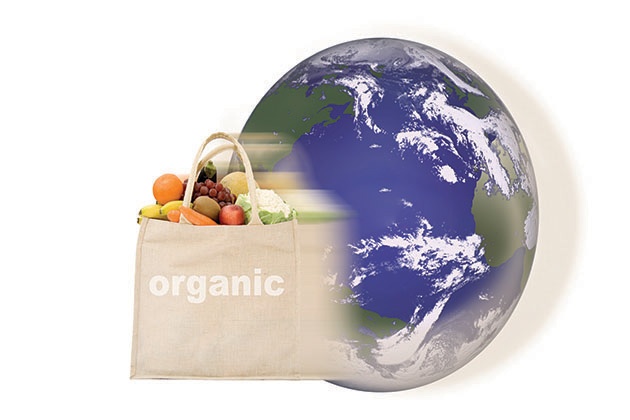अध्ययन से पता चलता है कि अधिक भूमि उपयोग के कारण जैविक रूप से बढ़ते भोजन का जलवायु पर अधिक प्रभाव पड़ता है
कार्बनिक food has become very popular in the last decade as consumers are becoming more aware and health and quality conscious. कार्बनिक food is produced naturally from जैविक खेती which aims to increase the naturalness of food by minimizing chemical interference when producing it. So, जैविक food does not include any pesticides, synthetic fertilizers or other artificial additives. The produce of meat, eggs and other products from animals, is termed जैविक if animals were not subjected to any antibiotics or growth hormone supplements. Every food item produced organically is also more expensive than conventional food because without use of chemicals or additives, it takes longer time to produce जैविक food and thus requires more resources in terms of land, time etc. The demand for जैविक खाद्य is certainly higher and rapidly growing compared to the supply which is further contributing to high prices of जैविक खाना.
Conventional farming vs जैविक खेती
चल्मर्स यूनिवर्सिटी ऑफ टेक्नोलॉजी, स्वीडन के शोधकर्ताओं ने के प्रभाव का विश्लेषण करने के लिए एक नई पद्धति विकसित की है जैविक खेती on जलवायु via the factor of land-use by comparing conventional food production in agriculture with जैविक production. Their study showed that producing जैविक food contributed to higher emissions into the वातावरण। उदाहरण के लिए, जैविक peas farmed in Sweden had almost 50 percent higher impact on climate while for other foods like Swedish winter wheat this number was as high as 70 percent. This is attributed to two reasons; first, to the more land required for जैविक farming and second, since fertilizers are not used in जैविक farming the yields per hectare is considerably reduced. For every single food product, be it organic meat or dairy product the land required is much more for organic production compared to conventional खेती. This greater land use automatically leads to higher carbon dioxide (CO2) emissions because for every land which needs to be cultivated, forests are converted by cutting trees leading to deforestation. Deforestation accounts for 15 percent of total greenhouse emissions on our ग्रह. Simply put, felling of trees is doing an irreversible damage to the environment and to the ecosystem (flora and fauna).
'कार्बन अवसर लागत'
में प्रकाशित उनके अध्ययन में प्रकृति शोधकर्ताओं ने पहली बार 'कार्बन अवसर लागत' नामक एक नए मीट्रिक का उपयोग किया जो उच्च भूमि उपयोग के प्रभावों के माध्यम से कार्बन पदचिह्न का मूल्यांकन करता है और यह वनों की कटाई से सीओ 2 उत्सर्जन में कैसे योगदान देता है। इसलिए, कुल खाद्य उपज के मुकाबले CO2 उत्सर्जन का चार्ट बनाया गया था जिसमें जैविक खाद्य का अनुपात निश्चित रूप से पिछड़ गया था। वनों में संग्रहीत कार्बन की मात्रा को ध्यान में रखा गया और वनों की कटाई के परिणामस्वरूप CO2 वातावरण में छोड़ी जाती है। आश्चर्यजनक रूप से, भूमि उपयोग कारक और CO2 उत्सर्जन पर इसके प्रभाव का विश्लेषण पहले किसी भी पिछले अध्ययन में नहीं किया गया है, शायद सीधे और आसानी से लागू होने वाले तरीकों की कमी के कारण। नई मीट्रिक 'कार्बन अवसर लागत' एक सरल लेकिन विस्तृत तुलना की अनुमति देती है। स्वीडिश बोर्ड ऑफ एग्रीकल्चर द्वारा देश में कुल उत्पादन और जैविक और पारंपरिक खेती के आंकड़ों के लिए प्रति हेक्टेयर कुल पैदावार प्रदान की गई।
कार्बनिक खेती never uses artificial fertilizers as the crops are nourished and nurtured through nutrients naturally present in the soil and if needed only natural pesticides are used. The flipside is that valuable resources like land, water and energy consumed are much higher in organic farming and its relevant to understand how it can be made sustainable over a period of time. According to this study consuming organically produced beans or chicken is better for the climate then let’s say conventionally produced beef. And eating pork, chicken, fish or eggs will have lower impact on environment than say eating beef or lamb.
हालाँकि, इस अध्ययन की सीमाएँ हैं - क्योंकि यह कुछ फसलों और देश के केवल एक क्षेत्र तक ही सीमित था। इसलिए, सिफारिश है कि जैविक भोजन का सेवन पूरी तरह से बंद न करें। लेकिन यह स्पष्ट है, जहां जलवायु पर प्रभाव का संबंध है, जैविक खाद्य पारंपरिक भोजन की तुलना में खराब है क्योंकि खेती methods. There is still lack of substantial scientific evidence to show that organic food is more health friendly or even environment friendly than conventionally farmed food. So even if one assumes organic food is better for people, it may not be so good for the ग्रह! More data is certainly needed to arrive to generalized conclusions. The analysis in this study could also be correlated to biofuels as their production also needs larger land area compared to conventional fuels.
***
{आप उद्धृत स्रोतों की सूची में नीचे दिए गए डीओआई लिंक पर क्लिक करके मूल शोध पत्र पढ़ सकते हैं}
स्रोत (रों)
खोजकर्ता टीडी एट अल। 2018 जलवायु परिवर्तन को कम करने के लिए भूमि उपयोग में परिवर्तन की दक्षता का आकलन। प्रकृति। 564 (7735)।
http://dx.doi.org/10.1038/s41586-018-0757-z






































